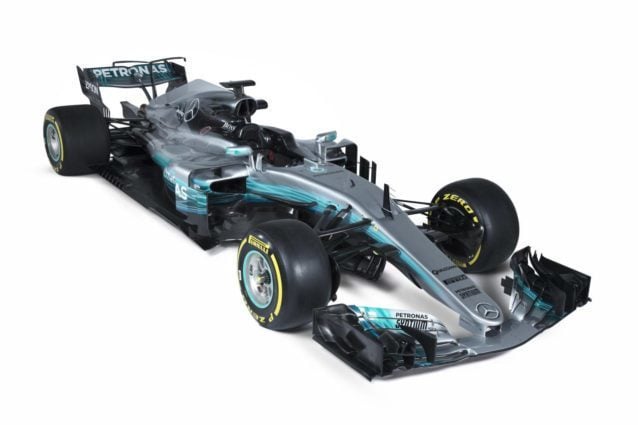
The first Formula 1 cars of the 2017 season were revealed earlier this week and gave us our first glimpse of what the racing will look like this year. Aggressive styling, wider tires and a renewed focus on aerodynamics means we will see cars travelling three to five seconds faster than previous years.
Corners that required a lift off the throttle will now likely be taken flat-out and the drivers will be able to hit the brakes even later. But while the cars are certainly more spectacular to look at, will we bear witness to an improvement in overtaking? Title favorites Mercedes kicked off the second batch of reveals on Thursday morning.
Mercedes AMG F1 W08 EQ Power+
The reigning Constructor’s Champion unveiled its 2017 challenger on a damp and windy day at the Silverstone Circuit. While running the car around the track for a scheduled filming session, Mercedes debuted an abnormal “whale tail” wing on top of the engine cover after discovering a clever loophole in the regulations. This unique interpretation of the rules could turn out to be one of the keys to success in 2017.
Mercedes’ chances could be further bolstered by the introduction of a re-designed Power Unit that boasts close to 1,000 hp and a primary focus on reliability after some mishaps cost the team valuable points last season.
As if Mercedes’ recent dominance of the sport wasn’t enough, another boost for 2017 comes in the form of a brand new fuel by suppliers Petronas. Three-time World Champion Lewis Hamilton is retained for a fifth year and is partnered with Finnish driver Valterri Bottas from Williams. The Finn replaces the reigning World Champion Nico Rosberg who shockingly retired at the end of last year.
A drive for Mercedes surely gives the talented Bottas his best chance at winning his elusive first race. Hamilton meanwhile will be looking for a fourth Driver’s title in a car that could bring Mercedes its fourth consecutive Constructor’s title.
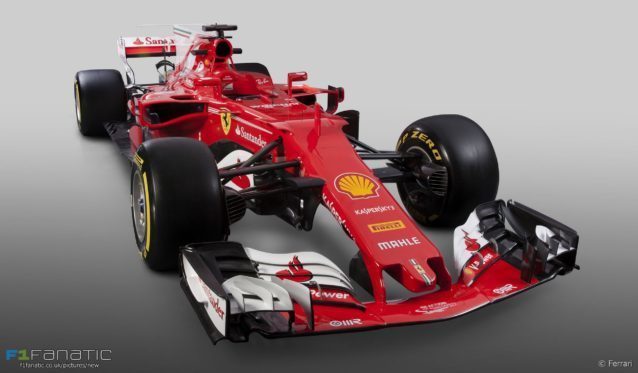
Scuderia Ferrari SF70H
This year’s Prancing Horse was arguably one of the more eye-catching reveals of 2017. The unique shape of the side pods, a “whale tail” wing on the engine cover as seen on the Mercedes and an abundance of turning vanes all over the car represent a Ferrari team that is clearly taking an aggressive path to get back to its winning ways.
From the looks of the car alone, the Scuderia seems adamant in mounting a serious challenge for the title. With three-time World Champion Sebastian Vettel and 2007 Champion Kimi Raikkonen staying on for their third and fifth tenures respectively, Ferrari clearly has the skill behind the wheel to get it done. With just four race wins in the past four years, the oldest team on the grid is hoping this new creation can bring back the dominance of years past.
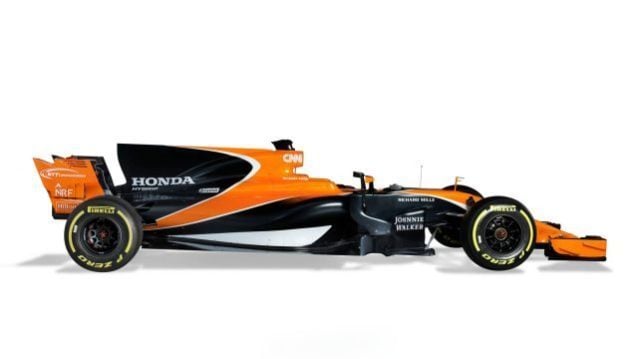
McLaren-Honda MCL32
In what was arguably the most eagerly anticipated launch of 2017, McLaren didn’t disappoint as it presented its car in a grandiose ceremony at its base in Woking, UK. In the weeks leading up to the launch, the team had been teasing a return to a famous identity in the form of a simple color: orange.
The significance of the hue is well-known: orange was the color team founder Bruce McLaren used when he raced the early cars in the late sixties. However, the color isn’t the only thing that’s changed this year at McLaren. A new management team has been put in place as former Chairman and CEO Ron Dennis parts ways with the company after thirty-five years, being replaced in-part by American Zak Brown.
There’s a new driver line-up, too. Rookie Stoffel Vandoorne take the place of the semi-retiring Jenson Button, but will have a challenge on his hands as he partners the double World Champion Fernando Alonso for 2017. Button will stay with the team as the test and reserve driver. With a new Honda Power Unit that, according to technical director Tim Goss, has been “specifically redesigned for this season” and what feels like a fresh start, McLaren has a great chance of finally finding some success again after four years without a race win.
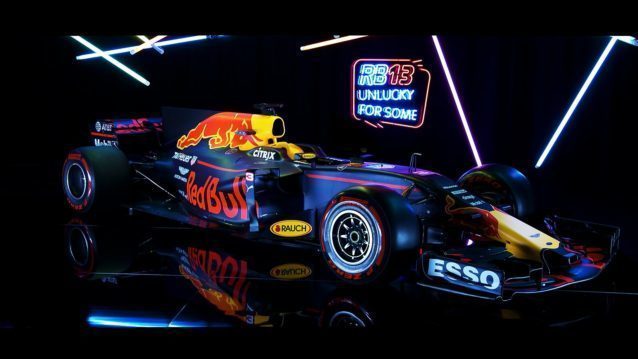
Red Bull Racing RB13
If McLaren’s reveal was the most revered launch of 2017, Red Bull’s certainly wasn’t far behind. As can be seen from the picture above, the car has been unleashed with a very peculiar nose.
The large inlet at the front of the nose will allow air to rush in as the car moves along, therefore reducing drag. The rules state that this is only allowed for “driver cooling”, but it wouldn’t be surprising if Red Bull is utilizing this “nostril” for something else entirely.
The team that has made a name for itself with its aerodynamic mastery must’ve relished the chance at designing a car under the new aero-heavy regulations. Because of this, Red Bull is generally regarded as the main team to mount a serious title fight with Mercedes this year. In what team boss Christian Horner has hailed as the strongest driver pairing on the grid, Daniel Ricciardo and Max Verstappen team up for a second successive year.
The young upstart Verstappen was promoted from Toro Rosso last year and showed flashes of brilliance on more than one occasion. Daniel “Honey Badger” Ricciardo will undoubtedly be as aggressive as ever to try to stop Max’s advances. Both drivers hope their charging bull can bring at least one of them some silverware in 2017.
As for the name of the car, Red Bull chief technical officer Adrian Newey dismissed the bad luck surrounding the number thirteen as just “superstition”. Red Bull will be hoping the writing isn’t on the wall as it tries to attain a fifth Constructor’s title.
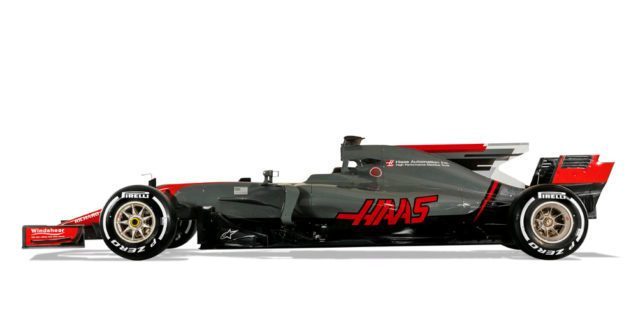
Haas VF-17
The American outfit started the season last year in spectacular fashion. Impressive results in the first few races surprised the paddock as the team made an unexpectedly successful start to the 2016 campaign. Things tapered off towards the end of the year, but a reset in the regulations can always shake up the order.
The team took what was learned about last year’s VF-1 and installed this knowledge into the 2017 challenger. A respectable overall finishing position of eighth in the Constructor’s standings last year could be beaten with a lighter and more aerodynamic package in the form of the VF-17.
Another driver moving teams in 2017 is Kevin Magnussen. After disagreeing with the way things were run at Renault in 2016, Kevin hopes the grass is greener on the other side at Haas. His team mate for 2017 is Frenchman Romain Grosjean who continues his stay at the team for a second term.
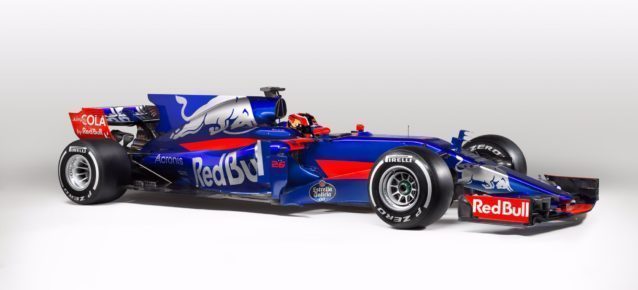
Scuderia Toro Rosso STR12
The STR12’s new livery promotes the Cola variant of the popular energy drink, but will the car turn out to be hyperactive or just mellowed out? The Italian team fell behind last year as it had to make do with a 2015 Ferrari power unit that was out-developed as the season went on.
However, Toro Rosso’s fortunes could improve as it takes on a 2017-spec Renault power unit that has seen major upgrades over last year, with a figure of 900bhp set to be on tap. Notably, Toro Rosso is the only team apart from Mercedes to go with a conventional nose for 2017, albeit in the form of a slightly slimmer design. When it comes to the talent behind the wheel, Toro Rosso acts as the “feeder” team for Red Bull, so turnover in drivers is usually rife.
Having said that, the team possesses the same pilots as last year. Carlos Sainz and Daniil Kyvat will work together in 2017 to try and at least hold onto their lucrative seats. Kyvat was demoted from Red Bull last year so some seat stability will do him good. With a new up-to-date engine and continuity behind the wheel, Toro Rosso would desperately enjoy a finish higher up the grid come the end of 2017.
With the wraps now taken off all the cars for this year, it’s time to see how they hold up going around a track. The first official F1 test begins today at the Circuit de Catalyuna in Barceonla, Spain. It will be an early chance for the teams get to run their cars in anger. However, as testing is more about reliability than outright performance, a pecking order likely won’t appear until the season opener in Australia at the end of March.
See more articles on F1 2017 Season and Pre-Season.

